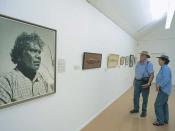Stylisation and artifice are the trademarks of contemporary Australian artist Tracey Moffatt's work, regardless of whether working in film, video, or photography. She is never engaged primarily with producing reality, with taking pictures, but with making pictures and creating her own reality. The worlds that Moffatt constructs, usually via a form of non-linear narrative, typically combine personal memories within a larger historical experience. Thus, although most of her key works are rooted in childhood experience or in cherished memories, ultimately they are neither subjective nor autobiographical.
Growing up in Mt. Gravatt, a working class suburb of Brisbane, Moffatt's adolescence was as shaped by pop culture and television as by her native heritage. Consequently, courses in visual communications at the Queensland College of Art allowed her to strengthen this early fascination with mainstream mass culture as well as giving her extensive exposure to an enormous range of works from the history of twentieth-century film, video, and photography.
Her earliest mature works, notably, the nine-part photo series "Something More" and the short film "Night Cries: A Rural Tragedy" combine these diverse determining interests with sophisticated comprehensiveness. Focusing on the exemplary relationship that communally binds a mother and daughter, in "Night Cries" she explores in extremely succinct yet affecting terms their interdependence, and through that issues of loss, separation, need, and rejection. This brief story is framed and interrupted with footage of Jimmy Little, a renowned Aboriginal entertainer, who lip-syncs the song that won him national acclaim in the 1950s. If Little represents a distinguished and early instance of integration between Aboriginal and white societies, the mother-daughter relationship points to a different phase in Australian race relations, to the time when it was official policy to remove Aboriginal children from the care of their natural parents and place them with foster families...



Definition
you need to define for your audience what Stylisation and artifice is. A little background about past accomplishments would be nice as well.
3 out of 3 people found this comment useful.